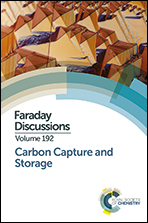Carbon Capture and Storage: concluding remarks
Abstract
This paper aims to pull together the main points, messages and underlying themes to emerge from the Discussion. It sets these remarks in the context of where Carbon Capture and Storage (CCS) fits into the spectrum of carbon mitigation solutions required to meet the challenging greenhouse gas (GHG) emissions reduction targets set by the COP21 climate change conference. The Discussion focused almost entirely on carbon capture (21 out of 23 papers) and covered all the main technology contenders for this except biological processes. It included (chemical) scientists and engineers in equal measure and the Discussion was enriched by the broad content and perspectives this brought. The major underlying theme to emerge was the essential need for closer integration of materials and process design – the use of isolated materials performance criteria in the absence of holistic process modelling for design and optimisation can be misleading. Indeed, combining process and materials simulation for reverse materials molecular engineering to achieve the required process performance and cost constraints is now within reach and is beginning to make a significant impact on optimising CCS and CCU (CO2 utilisation) processes in particular, as it is on materials science and engineering generally. Examples from the Discussion papers are used to illustrate this potential. The take-home messages from a range of other underpinning research themes key to CCUS are also summarised: new capture materials, materials characterisation and screening, process innovation, membranes, industrial processes, net negative emissions processes, the effect of GHG impurities, data requirements, environment sustainability and resource management, and policy. Some key points to emerge concerning carbon transport, utilisation and storage are also included, together with some overarching conclusions on how to develop more energy- and cost-effective CCS processes through improved integration of approach across the science-engineering spectrum. The discussion was first-rate in the best traditions of Faraday Discussions and hopefully will foster and stimulate further cross-disciplinary interactions and holistic approaches.
- This article is part of the themed collection: Carbon Capture and Storage


 Please wait while we load your content...
Please wait while we load your content...